【新版】冀教版小学六年级英语总复习资料
- 格式:docx
- 大小:30.62 KB
- 文档页数:10
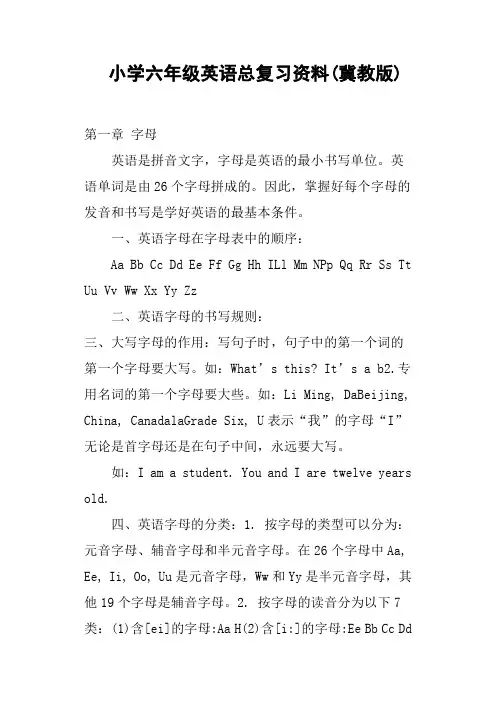
小学六年级英语总复习资料(冀教版)第一章字母英语是拼音文字,字母是英语的最小书写单位。
英语单词是由26个字母拼成的。
因此,掌握好每个字母的发音和书写是学好英语的最基本条件。
一、英语字母在字母表中的顺序:Aa Bb Cc Dd Ee Ff Gg Hh ILl Mm NPp Qq Rr Ss Tt Uu Vv Ww Xx Yy Zz二、英语字母的书写规则:三、大写字母的作用:写句子时,句子中的第一个词的第一个字母要大写。
如:What’s this? It’s a b2.专用名词的第一个字母要大些。
如:Li Ming, DaBeijing, China, CanadalaGrade Six, U表示“我”的字母“I”无论是首字母还是在句子中间,永远要大写。
如:I am a student. You and I are twelve years old.四、英语字母的分类:1. 按字母的类型可以分为:元音字母、辅音字母和半元音字母。
在26个字母中Aa, Ee, Ii, Oo, Uu是元音字母,Ww和Yy是半元音字母,其他19个字母是辅音字母。
2. 按字母的读音分为以下7类:(1)含[ei]的字母:Aa H(2)含[i:]的字母:Ee Bb Cc DdGg Pp Tt Vv (3)含[e]读音的字母:Ff Ll Mm Nn Ss Xx Zz (4)含[ai]的字母: Ii Yy (5)含[ju:]的字母: Uu Qq Ww(6)Oo (7)Rr五、常用英语缩略语:a.m.(上午) p.m.(下午)dm(分米) cm(厘米) mm(毫米) kg(千克) km(千米)B.C.(公元前) A.D.(公元) TV(电视) CCTV(中国中央电视台) CAAC(中国民航) UN(联合国) UK(英国) US(美国) USA(美国) PRC(中华人民共和国) UFO(不明飞行物) WTO(世界贸易组织) CBA(中国篮球职业协会) NBA(美国篮球职业协会) WC(厕所) CD(光盘) ID(身份证) PC(个人电脑) KFC(肯德基) ABC(基础知识)字母专项练习题一、按字母顺序默写出26个字母的大、小写形式,并写出5个元音字母。
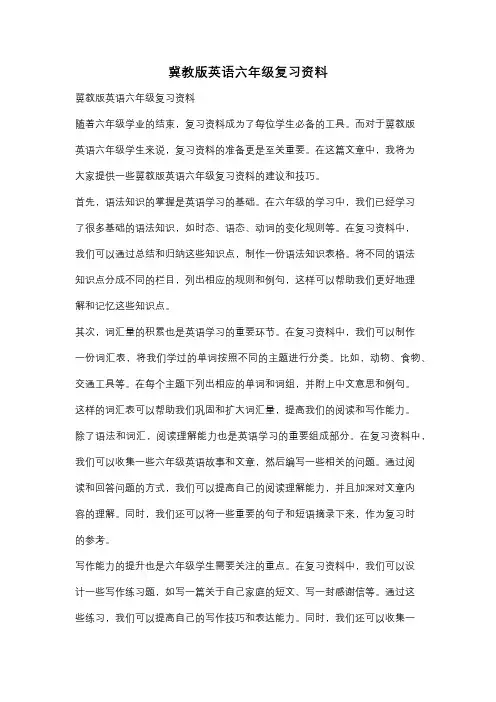
冀教版英语六年级复习资料冀教版英语六年级复习资料随着六年级学业的结束,复习资料成为了每位学生必备的工具。
而对于冀教版英语六年级学生来说,复习资料的准备更是至关重要。
在这篇文章中,我将为大家提供一些冀教版英语六年级复习资料的建议和技巧。
首先,语法知识的掌握是英语学习的基础。
在六年级的学习中,我们已经学习了很多基础的语法知识,如时态、语态、动词的变化规则等。
在复习资料中,我们可以通过总结和归纳这些知识点,制作一份语法知识表格。
将不同的语法知识点分成不同的栏目,列出相应的规则和例句,这样可以帮助我们更好地理解和记忆这些知识点。
其次,词汇量的积累也是英语学习的重要环节。
在复习资料中,我们可以制作一份词汇表,将我们学过的单词按照不同的主题进行分类。
比如,动物、食物、交通工具等。
在每个主题下列出相应的单词和词组,并附上中文意思和例句。
这样的词汇表可以帮助我们巩固和扩大词汇量,提高我们的阅读和写作能力。
除了语法和词汇,阅读理解能力也是英语学习的重要组成部分。
在复习资料中,我们可以收集一些六年级英语故事和文章,然后编写一些相关的问题。
通过阅读和回答问题的方式,我们可以提高自己的阅读理解能力,并且加深对文章内容的理解。
同时,我们还可以将一些重要的句子和短语摘录下来,作为复习时的参考。
写作能力的提升也是六年级学生需要关注的重点。
在复习资料中,我们可以设计一些写作练习题,如写一篇关于自己家庭的短文、写一封感谢信等。
通过这些练习,我们可以提高自己的写作技巧和表达能力。
同时,我们还可以收集一些常用的句型和表达方式,作为写作时的参考。
最后,口语能力的培养也是英语学习的重要环节。
在复习资料中,我们可以设计一些口语练习题,如模拟对话、角色扮演等。
通过这些练习,我们可以提高自己的口语表达能力和交流能力。
同时,我们还可以收集一些常用的口语表达和口头禅,作为口语练习时的参考。
综上所述,冀教版英语六年级复习资料的准备是一项重要的任务。
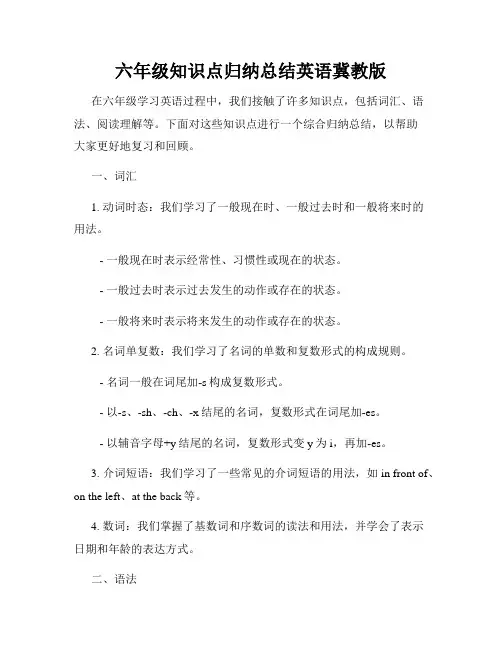
六年级知识点归纳总结英语冀教版在六年级学习英语过程中,我们接触了许多知识点,包括词汇、语法、阅读理解等。
下面对这些知识点进行一个综合归纳总结,以帮助大家更好地复习和回顾。
一、词汇1. 动词时态:我们学习了一般现在时、一般过去时和一般将来时的用法。
- 一般现在时表示经常性、习惯性或现在的状态。
- 一般过去时表示过去发生的动作或存在的状态。
- 一般将来时表示将来发生的动作或存在的状态。
2. 名词单复数:我们学习了名词的单数和复数形式的构成规则。
- 名词一般在词尾加-s构成复数形式。
- 以-s、-sh、-ch、-x结尾的名词,复数形式在词尾加-es。
- 以辅音字母+y结尾的名词,复数形式变y为i,再加-es。
3. 介词短语:我们学习了一些常见的介词短语的用法,如in front of、on the left、at the back等。
4. 数词:我们掌握了基数词和序数词的读法和用法,并学会了表示日期和年龄的表达方式。
二、语法1. 一般疑问句:我们学习了构成一般疑问句的方法,即将助动词或be动词提到句首。
- Can you swim?(你会游泳吗?)- Is she a teacher?(她是老师吗?)2. 选择疑问句:我们学习了构成选择疑问句的方法,即在句末使用or not。
- Do you like apples or not?(你喜欢苹果还是不喜欢?)- Is he from Beijing or not?(他是不是来自北京?)3. 情态动词:我们学习了情态动词can、could、may、might、must、shall、should、will、would等的用法。
- Can I go to the restroom, please?(我可以去洗手间吗?)- You should listen to your parents.(你应该听父母的话)4. 定语从句:我们掌握了定语从句的构成和用法,即用关系词(who、whom、whose、which、that)来引导从句。
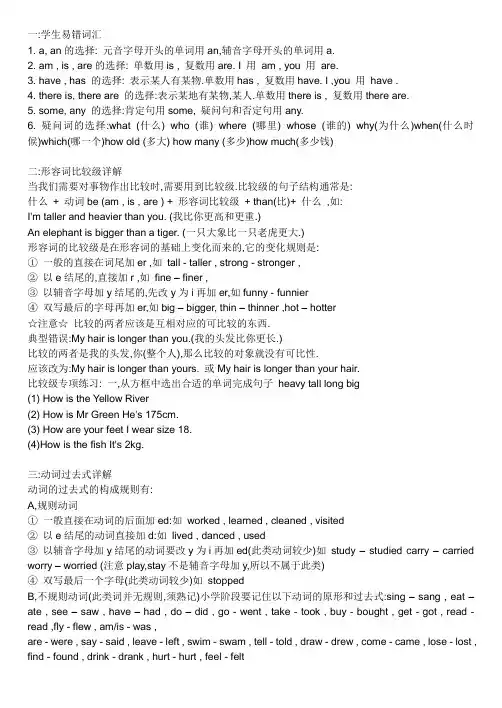
一:学生易错词汇1. a, an的选择: 元音字母开头的单词用an,辅音字母开头的单词用a.2. am , is , are的选择: 单数用is , 复数用are. I 用am , you 用are.3. have , has 的选择: 表示某人有某物.单数用has , 复数用have. I ,you 用have .4. there is, there are 的选择:表示某地有某物,某人.单数用there is , 复数用there are.5. some, any 的选择:肯定句用some, 疑问句和否定句用any.6. 疑问词的选择:what (什么) who (谁) where (哪里) whose (谁的) why(为什么)when(什么时候)which(哪一个)how old (多大) how many (多少)how much(多少钱)二:形容词比较级详解当我们需要对事物作出比较时,需要用到比较级.比较级的句子结构通常是:什么+ 动词be (am , is , are ) + 形容词比较级+ than(比)+ 什么,如:I'm taller and heavier than you. (我比你更高和更重.)An elephant is bigger than a tiger. (一只大象比一只老虎更大.)形容词的比较级是在形容词的基础上变化而来的,它的变化规则是:①一般的直接在词尾加er ,如tall - taller , strong - stronger ,②以e结尾的,直接加r ,如fine – finer ,③以辅音字母加y结尾的,先改y为i再加er,如funny - funnier④双写最后的字母再加er,如big – bigger, thin – thinner ,hot – hotter☆注意☆比较的两者应该是互相对应的可比较的东西.典型错误:My hair is longer than you.(我的头发比你更长.)比较的两者是我的头发,你(整个人),那么比较的对象就没有可比性.应该改为:My hair is longer than yours. 或My hair is longer than your hair.比较级专项练习: 一,从方框中选出合适的单词完成句子heavy tall long big(1) How is the Yellow River(2) How is Mr Green He's 175cm.(3) How are your feet I wear size 18.(4)How is the fish It's 2kg.三:动词过去式详解动词的过去式的构成规则有:A,规则动词①一般直接在动词的后面加ed:如worked , learned , cleaned , visited②以e结尾的动词直接加d:如lived , danced , used③以辅音字母加y结尾的动词要改y为i再加ed(此类动词较少)如study – studied carry – carried worry – worried (注意play,stay不是辅音字母加y,所以不属于此类)④双写最后一个字母(此类动词较少)如stoppedB,不规则动词(此类词并无规则,须熟记)小学阶段要记住以下动词的原形和过去式:sing – sang , eat –ate , see – saw , have – had , do – did , go - went , take - took , buy - bought , get - got , read - read ,fly - flew , am/is - was ,are - were , say - said , leave - left , swim - swam , tell - told , draw - drew , come - came , lose - lost , find - found , drink - drank , hurt - hurt , feel - felt四:动词现在分词详解动词的ing形式的构成规则:①一般的直接在后面加上ing , 如doing , going , working , singing , eating②以e 结尾的动词,要先去e再加ing ,如having , writing③双写最后一个字母的(此类动词极少)有:running , swimming , sitting , getting五:人称代词与物主代词一、人称代词六:句型专项归类1.肯定句:是指用肯定的语气来陈述的句子,如:I'm a student. She is a doctor. He works in a hospital. There are four fans in our classroom. He will eat lunch at 12:00. I watched TV yesterday evening. 2,否定句:含有否定词或表示否定意义词的句子,如:I'm not a student. She is not (isn't) a doctor.He does not (doesn't) work in a hospital. There are not (aren't) four fans in our classroom.He will not (won't) eat lunch at 12:00. I did not (didn't) watch TV yesterday evening.☆注意☆小结:否定句主要是在肯定句的基础上加上了否定词"not".有动词be的句子则"not"加在be 后面,可缩写成"isn't,aren't",但am not 一般都分开写.没有动词be的句子则要先在主要动词的前面加上一个助动词(do,does,did),然后在它后面加上"not",你也可以把它们缩写在一起如"don't , doesn't , didn't ).这三个助动词要根据人称和时态来选择,其中"does"只用于一般现在时主语是第三人称单数的情况,而"did"只用于一般过去时,不论主语是什么人称和数,都用"did" .3,一般疑问句:是指询问事实的句子,此类句子必须用"yes",或"no"来回答.如:Are you a student Yes, I am / No, I'm not.Is she a doctor Yes, she is. / No, she isn't.Does he work in a hospital Yes, he does. / No, he doesn't.Are there four fans in our classroom Yes, there are. / No, there aren't.Are you going to buy a comic book tonight Yes, I am. / No, I am not. (Yes, we are. / No, we aren't.) Will he eat lunch at 12:00 Yes, I will. / No, I will not(won't).Are they swimming Yes, they are. / No, they aren't.Did you watch TV yesterday evening Yes, I did. / No, I didn't.☆注意☆小结:一般疑问句是在肯定句的基础上,①把动词be调到首位,其他照写,末尾标点符号变成问号即可.②没有动词be的句子则要在句首加上一个助动词(do,does,did)再把紧跟在后面的动词变回原形,末尾标点符号变成问号即可.这三个助动词也要根据人称和时态来选择,其中"does"只用于一般现在时主语是第三人称单数的情况,而"did"只用于一般过去时,不论主语是什么人称和数,都用"did" .一般疑问句有个重要的原则就是问和答要一致,即问句里的第一个单词(助动词)和简略答句里的这个词是一致的.4,特殊疑问句:以特殊疑问词(what , where , who , which , when , whose , why , how等)开头引导的句子.此类句子应该问什么就答什么,不能用"yes ,no"来回答.如:What is this It's a computer.What does he do He's a doctor.Where are you going I'm going to Beijing.Who played football with you yesterday afternoon Mike.Which season do you like best Summer.When do you usually get up I usually get up at 6:30.Whose skirt is this It's Amy's.Why do you like spring best Because I can plant trees.How are you I'm fine. / I'm happy.How did you go to Xinjiang I went to Xinjiang by train.☆其中how又可以和其他一些形容词连用组成特殊疑问词组用来提问,如: how many(多少(数量)), how much(多少(钱)), how tall(多高), how long(多长), how big(多大), how heavy(多重)例句:How many pencils do you have I have three pencils.How many girls can you see I can see four girls.How many desks are there in your classroom There are 51.☆小结:how many 用来提问可数名词的数量,主要有以上三种句式搭配,How many + 名词复数+ do you have 你有多少……How many + 名词复数+ can you see 你能看见多少……How many + 名词复数+ are there… 有多少……七:完全,缩略形式: I'm=I am he's=he is she's=she is they're=they are you're=you are there's=there is they're=they are can't=can not don't=do not doesn't=does not isn't=is not aren't=are not let's=let us won't=will notI'll=I will wasn't=was not总结:通常情况下,'m即am,'s即is(但let's=let us), 're即are,n't即not (但can't=can not)八:小学英语词汇不完全归类表学习用品(school things):pen钢笔pencil铅笔pencil-case铅笔盒ruler尺子book书bag包comic book漫画书post card明信片newspaper报纸schoolbag书包eraser橡皮crayon蜡笔story-book故事书notebook笔记本Chinese book语文书English book英语书人体(body):foot(feet)脚head头face脸hair头发nose鼻子mouth嘴eye眼睛ear耳朵arm手臂hand手finger手指leg腿tail尾巴颜色(colours):red红blue蓝yellow黄green绿white白black黑pink粉红purple紫orange橙brown棕动物(animals):cat猫dog狗pig猪duck鸭rabbit兔horse马elephant大象ant蚂蚁fish鱼bird鸟snake蛇mouse老鼠kangaroo袋鼠monkey猴panda熊猫bear熊lion狮子tiger老虎fox狐狸zebra斑马deer鹿giraffe长颈鹿lamb小羊sheep绵羊goat山羊cow奶牛donkey 驴人物(people):friend朋友boy男孩girl女孩mother母亲father父亲sister姐妹brother兄弟uncle叔叔;舅舅man男人woman女人Mr.先生Miss小姐mom妈妈dad爸爸parents父母grandparents祖父母grandma/grandmother(外)祖母grandpa/grandfather(外)祖父aunt姑姑cousin堂(表)兄弟;堂(表)姐妹son儿子daughter女儿baby婴儿children儿童classmate同学queen女王student大学生people人物职业(jobs):teacher教师student学生doctor医生nurse护士driver司机farmer农民singer歌唱家writer作家actor男演员actress女演员artist画家TV reporter电视台记者policeman(男)警察cleaner清洁工police警察食品,饮料(food & drink):rice米饭bread面包beef牛肉milk牛奶water水egg蛋fish鱼cake蛋糕hot dog热狗hamburger汉堡包French fries炸薯条cookie曲奇饼干jam果酱noodles面条meat肉chicken鸡肉meat 肉mutton羊肉vegetable蔬菜soup汤ice冰ice-cream冰淇淋Coke可乐juice果汁tea茶coffee咖啡breakfast早餐lunch午餐dinner/supper晚餐水果,蔬菜(fruit & vegetables):apple苹果banana香蕉pear梨orange橙watermelon西瓜grape葡萄eggplant茄子green beans青豆tomato西红柿potato土豆peach桃strawberry草莓onion洋葱carrot胡萝卜cabbage卷心菜衣服(clothes):jacket夹克衫shirt衬衫T-shirt丅恤衫skirt短裙子dress连衣裙jeans牛仔裤pants长裤socks袜子shoes鞋子sweater毛衣coat上衣raincoat雨衣shorts短裤slippers拖鞋sandals凉鞋boots靴子hat(有沿的)帽子cap便帽sunglasses太阳镜scarf围巾gloves手套交通工具(vehicles):b ike自行车bus公共汽车train火车boat小船ship轮船car小汽车taxi出租车jeep吉普车truck卡车plane/airplane飞机杂物(other things): window窗户door门desk课桌chair椅子bed床computer计算机board写字板light灯teacher's desk讲台picture图画;照片photo照片wall墙壁floor地板closet壁橱end table床头柜football/soccer足球walkman随身听lamp台灯(on the)phone电话table桌子TV电视key钥匙lock锁chart图表plate盘子knife 刀spoon勺子chopsticks筷子gift礼物toy玩具doll洋娃娃ball球balloon气球kite风筝box盒子umbrella伞violin小提琴yo-yo溜溜球hole洞tube管子toothbrush牙刷e-mail电子邮件traffic light交通灯money钱地点(locations):home家room房间bedroom卧室bathroom卫生间living room起居室kitchen 厨房classroom教室school学校park公园library图书馆post office邮局police office警察局hospital医院bookstore书店farm农场zoo动物园garden花园study书房playground操场teacher's office教师办公室library图书馆gym体育馆washroom卫生间computer room计算机教室music room音乐教室TV room电视机房the Great Wall长城supermarket超市bank银行country国家city城市bus stop公交车站国家,城市(countries & cities): China/PRC中国America/ the USA美国the UK/ England英国Canada/CAN加拿大Australia澳大利亚New York纽约London伦敦Sydney悉尼Moscow莫斯科Cairo开罗气象(weather):cold寒冷的warm温暖的cool凉爽的snowy下雪的sunny晴朗的hot炎热的rainy下雨的windy有风的cloudy多云的weather report天气预报景物(nature): river河流lake湖泊溪forest森林road公路house房子building建筑物rain 雨cloud云sun太阳mountain山sky天空rainbow彩虹wind风air空气moon月亮植物(plants): flower花grass草tree树rose玫瑰leaf叶子( leaves复数)星期(week): Monday星期一Tuesday星期二Wednesday星期三Thursday星期四Friday星期五Saturday星期六Sunday星期天weekend周末月份(months): Jan. (January)一月Feb.(February)二月Mar.(March)三月April四月May五月June六月July七月Aug.(August)八月Sept.(September)九月Oct.(October)十月Nov.(November)十一月Dec.(December)十二月季节(seasons): spring春summer夏fall/autumn秋winter冬方位south南north北east东west西left 左边right右边患病(illness):have a fever发烧hurt疼痛have a cold感冒have a toothache牙疼have a headache头疼数词(numbers): one一two二three三four四five五six六seven七eight八nine九ten十eleven十一twelve十二thirteen十三fourteen十四fifteen十五sixteen十六seventeen十七eighteen十八nineteen十九twenty二十thirty三十forty四十fifty五十sixty六十seventy七十eighty八十ninety九十forty-two四十二hundred百one/a hundred and thirty-six一百三十六first第一second第二third第三fourth第四fifth第五eighth第八ninth第九twelfth第十二twentieth第二十thirtieth第三十fortieth第四十fiftieth第五十sixtieth第六十seventieth第七十eightieth第八十ninetieth第九十fifty-sixth第五十六形容词(adj.): big大的(比较级bigger than更大的)small小的----smaller更小的long长的---- longer更长的tall高的---- taller更高的short短的;矮的---- shorter更矮high高的----higher更高的low低的young年轻的-----younger更年轻的new新的old旧的;老的-----older年龄更大的strong健壮的-----stronger更强壮的thin瘦的-----thinner更瘦的heavy重的-----heavier更重的light轻的---lighter更轻的quiet安静的nice好看的kind和蔼亲切的funny滑稽可笑的salt盐---salty咸的favourite最喜爱的clean干净的tired疲劳的excited兴奋的good好的fine好的great很好的fat胖的sad忧愁的----happy快乐的高兴的right对的hungry饥饿的---- eat吃thirsty口渴的----- drink 喝lovely可爱的beautiful漂亮的colourful色彩鲜艳的pretty漂亮的cheap便宜的expensive昂贵的healthy健康的helpful有帮助的easy简单的sick有病的better更好的介词(prep.):in在……里on在……上;在……时候under在……下面near在……的旁边behind在……后边next to与……相邻abver在……上面in front of在……前面代词(pron.):I我we我们you你;你们he他she她it它they他(她,它)们my我的our 我们的your你的;你们的his他的her她的。
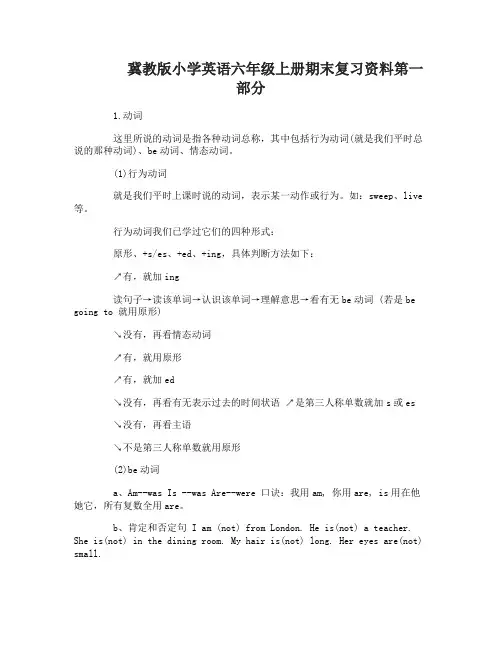
冀教版小学英语六年级上册期末复习资料第一部分1.动词这里所说的动词是指各种动词总称,其中包括行为动词(就是我们平时总说的那种动词)、be动词、情态动词。
(1)行为动词就是我们平时上课时说的动词,表示某一动作或行为。
如:sweep、live 等。
行为动词我们已学过它们的四种形式:原形、+s/es、+ed、+ing,具体判断方法如下:↗有,就加ing读句子→读该单词→认识该单词→理解意思→看有无be动词 (若是be going to 就用原形)↘没有,再看情态动词↗有,就用原形↗有,就加ed↘没有,再看有无表示过去的时间状语↗是第三人称单数就加s或es↘没有,再看主语↘不是第三人称单数就用原形(2)be动词a、Am--was Is --was Are--were 口诀:我用am, 你用are, is用在他她它,所有复数全用are。
b、肯定和否定句 I am (not) from London. He is(not) a teacher. She is(not) in the dining room. My hair is(not) long. Her eyes are(not) small.c、一般疑问句Am I a Chinese? Yes, you are. No, you aren’t. Are they American? Yes, they are. No, they aren’t. Is the cat fat? Yes, it is. No, it isn’t.我们现在学过的be动词大致分两类:is、am、are为一类,一般用于一般现在时、现在进行时和一般将来时中,was和were为另一类,一般用于一般过去时。
判断步骤:↗第一、三人称单数,就用was↗有,再看人称↘第二人称单数和所有复数,就用were看有无表示过去的时间状语↗第一人称单数,就用am↘没有,再看人称→第三人称单数,就有is↘第二人称单数和所有复数,就用are(3)情态动词情态动词也是一类特殊的动词,平时我们不把它说成是动词。
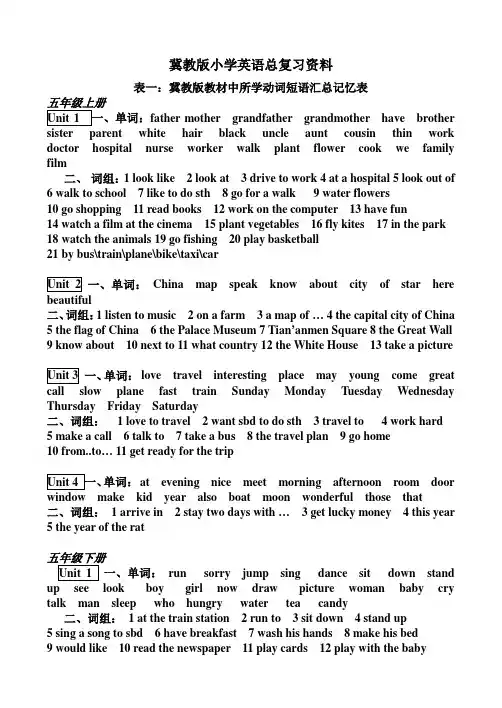
冀教版小学英语总复习资料表一:冀教版教材中所学动词短语汇总记忆表father mother grandfather grandmother have brotherwhite hair black uncle aunt cousin thin work doctor hospital nurse worker walk plant flower cook we family film二、词组:1 look like 2 look at 3 drive to work 4 at a hospital 5 look out of6 walk to school7 like to do sth8 go for a walk9 water flowers10 go shopping 11 read books 12 work on the computer 13 have fun14 watch a film at the cinema 15 plant vegetables 16 fly kites 17 in the park 18 watch the animals 19 go fishing 20 play basketball21 by bus\train\plane\bike\taxi\car一、单词:China map speak know about city of star here二、词组:1 listen to music 2 on a farm 3 a map of … 4 the capital city of China5 the flag of China6 the Palace Museum7 Tian’anmen Square8 the Great Wall9 know about 10 next to 11 what country 12 the White House 13 take a picture一、单词:love travel interesting place may young come great call slow plane fast train Sunday Monday Tuesday Wednesday Thursday Friday Saturday二、词组: 1 love to travel 2 want sbd to do sth 3 travel to 4 work hard5 make a call6 talk to7 take a bus8 the travel plan9 go home10 from..to… 11 get ready for the trip单词:at evening nice meet morning afternoon room door window make kid year also boat moon wonderful those that二、词组: 1 arrive in 2 stay two days with … 3 get lucky money 4 this year5 the year of the rat一、单词:run sorry jump sing dance sit down standlook boy girl now draw picture woman baby cry talk man sleep who hungry water tea candy二、词组: 1 at the train station 2 run to 3 sit down 4 stand up5 sing a song to sbd6 have breakfast7 wash his hands8 make his bed9 would like 10 read the newspaper 11 play cards 12 play with the baby单词:people many child women men say help worry sadtired stop wait afraid for busy二、词组:1 arrive in 2 on the way to the hotel 3 many people 4 on the square5 at the Palace Museum6 be careful7 on the way back to …8 feel tired9 too many 10 be afraid 11 on Wangfujing Street 12 in fifteen shops13 a visit to the Great Wallmuch write mum dad dear fine left right turn idea computer use kind us二、词组:1 write a letter\an email 2 send …to… 3 be far from 4 on the right5 on the left6 the post office7 turn left at the traffic lights8 write…to…9 good idea 10 say hello to 11 thank you for…12 a gift from…story did yesterday night had went saw ate photo were was happy bought back二、词组:1 buy a gift for … 2 last night 3 at home 4 wash the clothes5 call my friend6 every day7 the train to Beijing8 buy…for…9 have a great timehouse study kitchen toilet floor there breakfast table put half dinner dirty lunch me him card them Mr. Mrs.二、词组:1 learn English 2 half past four 3 sit down 4 come in5 on the first floor6 cook eggs7 in the fridge8 put …on(in) the…9 make breakfast(lunch/dinner) 10 help sbd do sth 11 on the table12 sit in a chair 13 in front of 14 play cards 15 write a letter 16 on the floor 17 sit at a small table 18 clean the bedroomMs. Driver well class ill lesson its word always sometimes二、词组: 1 on a rainy day 2 the bus stop 3 the school bus 4 bus driver5 walk to school6 be far from7 what subject8 a science lesson9 get to work 10 zero degrees 11 the temperature of … 12 do one’s homework 13 after class 14 go to the cinemasummer autumn winter put on take offagain body nose mouth head ear arm leg eye think can why二、词组:1 put on 2 take off 3 get out to play with… 4 make a snowman5 make a face6 skate over to..7 fall down8 love to swim in the seagive song tomorrow then put up open little二、词组:1 a Western holiday 2 on a holiday 3 at Christmas 4 put up5 invite sbd to…6 bring sth for sbd7 Merry Christmas8 a card with…9 write …to… 10 a gift from…10 go and see 11 ask sbd to do sth12 give sbd sth==give sth to sbdsport football any some wear or basketball try heavy difficult easy hand game ask very answer policeman二、词组:1 what sports 2 play football 3 play basketball 4 too heavy5 teach sbd to do sth6 learn to do sth7 be ready to do sth8 want to do sth9 too difficult 10 hit the ball to…11 a good basketball player 12 each other 13 a basketball game 14 watch sbd do sth 15 play with 16 yell for17 of all sports 18 wear a T-shirt to play ping-pong 19 go shopping20 on Sunday 21 would like 22 have …for breakfast 23 at the sports shop 24 have fun 25 play basketball with a ping-pong ball 26 play basketball for funbefore after bad next often exercise minute hour high二、词组:1 be good for 2 last week 3 how often 4 six times5 good work6 on Tuesday morning7 before breakfast8 be bad for9 five times a week 10 from…to.. . 11 get up 12 work hard 13 on those days 14 eat vegetables 15 twice a week 16 make your body healthy and strong17 walk home 18 an hour of exercise 19 watch more sports on TV20 play sports for exercise 21 have fun with…22 water the flowers23 what else 24 on Saturdays 25 want to be healthy 26 do exerciseUnit 3 What will you do this summer?一、单词:fan close angry lake swim ship visit clever二、词组:1 in different seasons 2 like to do sth 3 sit in the sun4 summer fun5 look at the clouds6 play sports with…7 pick the flowers for...8 be angry 9 go on trips 10 play on the beach 11 swim in the sea 12 fly home13 go swimming 14 watch the ships and boats on the sea 15 fly to China16 feel happy to do sth 17 be in China for the summer holiday 18 close the door 19 next week 20 say hello to…tell begin late early cake every all good-bye hear二、词组:1 next week 2 buy sth for sbd 3 what about …4 a surprise for…5 a photo of…6 talk to sbd7 look at the photos8 a party for …9 tell sbd about …10 know about 11 all of the people12 leave for… 13 the plane for…14 say to … 15 want sbd to do sth16 have a good trip 17 forget to do sth 18 arrive for the party19 a very big forest 20 want to buy…21 get ready to 22 go home23 on the playground 24 arrive for the party表二:冀教版教材中所学过的不规则动词的过去式分类记忆表1. am ,is-was, are-were, do/does-did, go-went, see-saw, say-said, have/has-had, fly-flew, speak-spoke, buy-bought, bring-brought, think-thought, teach-taught, eat-ate, can-could, will-would. give-gave, get-got, forget-forgot, come-came,run-ran, sing-sang, write-wrote, draw-drew, drink-drank, ride-rode,swim-swam, shine-shone, find-found, win-won, lose-lost, make-made.2.read-read, put-put, hit-hit, hurt-hurt,表三:冀教版教材中所学的对应词和反义词汇总记忆表boy-girl, man-woman, brother-sister, father-mother, dad-mum,grandfather-grandmother , uncle-aunt, day-night, morning-afternoon, east-west, north-south, big-small, old-new, old-young, tall-short, long-short, left-right wrong-right, black-white, good-bad, happy-sad, dirty-clean, heavy-lighthungry-full, cold-hot, warm-cool, fat-thin, dry-wet, hard-easy, , far-near,high-low strong-weak, healthy-sick, different-same, here-there, late-earlyalways-never, inside-outside, up-down, this-that, these-those last--nextcome-go, yes-no, stand-sit, open-close, ask-answer, bring-take cry-laugh, teach-learn, before-after, above-below arrive-leave, forget-remember,put on-take off, stand-sit, this-that, these –those , catch-throw fast-slowin front of-behind , busy-free表四:冀教版教材中所学的同音词汇总记忆表buy-by-bye, two-too-to, I-eye, four-for, hi-high, know-no, hear-here,their -there, meet-meat, sun-son, see-sea, hour-our, write-right, where -wear weak -week, new-knew(know的过去式), one-won(win的过去式), its-itsMiss-miss, May-may表五:冀教版教材中常用交际用语汇总记忆表1 问候:Hi! Hello! Good morning/afternoon/evening!Nice to meet you! Nice to meet you, too.A :How are you? B: Fine, thank you./Very well, thank you.2 介绍:My name is ____. / I am a student. / I’m from Canada. /This is ______.3 告别:Good-bye! /Bye! /Bye-bye! Good night! See you later /tomorrow!4 感谢:Thank you(very much)/ Thanks a lot. –That’s OK. / That’s All right. / You are welcome. / Not at all.5 道歉:-Sorry. / I am sorry. -That’s OK. / It’s all right.6 邀请Would you like to go for a walk? /Will /Would you come to my birthday party?-Sure. / No, thanks.7 请求允许:-May I go on a trip to Beijing?-Yes, you may. / No, you may not. / Sure. / Certainly.-Can I use your pencil?-Of course, you can.8 祝愿与祝贺:Have a lovely day! / Good luck! / Happy New Y ear! / Merry Christmas!./ The same to you. -Happy birthday!-Thank you.9 约会:A: Would you like to play with me this afternoon?B: Yes. When? A: At 12:00.B: See you then.\10电话:A: Hello! May I speak to Mr. Wood?B: Yes, just a moment, please.A: Hello! Is Kim there? B: No /Sorry, can I take a message.A: Who is speaking? B: It’s Jenny speaking(calling).11 就医:A: What’s the matter?/What’s wrong with you?B:I hurt my finger. I have a headache /stomachache.12 就餐:A:Would you like something to eat / drink? B: Yes. I would like rice and chicken. A: What would you like? B:I would like some tea.A: Would you like some more dumplings? B: Yes, please. / No, thanks / thank you .A: May I have some more soup? B: It’s delicious. Sure / OK.14 问路:A: Excuse me. Do you know where is the________?B: Yes. Go straight down the street. Turn left /turn right.15 提供帮助:A: Can I help you? /May I help you? B: Yes, please. / No, thanks.16 询问对方姓名:A: What’s your name? B: My name is ____.A: What’s his/ her name? B: His /her name is ___.A: Who are you? B: I’m _____.17 询问在哪儿:A: Where is the book? B: It is on the desk.A: Where is Jenny? B: She is behind Danny.18 询问时间:A: What time is it? B: It’s seven.A: When is Teachers’Day? B: It’s on September tenth.19 询问地址和住址:A: Where are you from? B: I’m from Canada.A: What’s your address? B: My address is 111 Park Road.A: Where do you live? B: I live in an apartment.20 询问日期A: What day is today? B: It’s Monday.A: What day is tomorrow? B: It’s Tuesday.A: What day was yesterday? B: It was Sunday.A: What’s the date? B: It’s October 19th.21 询问对方最喜欢的事物A:What’s your favourite colour /food / fruit /shape/ season?B: My favourite colour is white.22 询问数量A: How many pencils do you have? B: I have 10 pencils.A: How many birds can you see? B: I can see 20 birds. A: How many days are there in a week? B: There are seven days in a week.23 询问价钱A: How much is the scarf? B: Twenty yuan.A: How much are the runners? B: They are thirty dollars.24论天气气温:A: How’s the weather today? B: It’s sunny/cloudy/windy/snowy.A: What’s the temperature? B: It’s _______degrees.25 询问年龄A: How old are you? B:I’m fourteen years old.A: How old is she/ he? B: He/ She is twenty .26 询问身高A: How tall are you? B: I’m 1.6 metres tall.A: How tall is she/ he? B: She/ he is 1.7 metres tall.27 询问事情发生的频率A: How often do you play basketball? B: About once a week.A: How often does my mother clean my bedroom? B: Twice a day.28询问事情距离长短:A: How long is the trip? B: About two hours to Beijing.A: How long does he go to school a day ? B: Eight hours.29 询问路程的远近:A: How far is it from here to Beijing? B: It’s one hundred kilometres.30 询问对方感觉怎么样: A:How do you feel? B: I feel sad.31 询问对方是谁,问谁在做些什么?A: Who is this? B: This is a man.A: Who is talking? B: Danny is talking.32 询问东西是谁的A: Whose hat is this? B: This is my hat /mine.33 询问原因:A: I like to eat vegetables. Why?B: Because it’s good for your health.34 询问温度?A : What’s the temperature ? B : It’s 10 degrees.A : What’s the chicken’s temperature ? B: Its temperature is ….表六:冀教版教材中固定句型总记忆表1 Did you have a good trip ?2 Let’s +动词原形。

冀教版英语六年级上册课本知识点总结(期末复习资料)Unit 11. There is a kitchen, a living room and a bathroom on the first floor.2. There is some water everywhere in the bathroom.3. There are four bedrooms and a study on the second floor.There be句型:表示某处有某物,翻译为“有”is +可数名词单数/不可数名词遵循就近原则:Thereare+可数名词复数4. -- What time is it now? 同义句:What’s the time?-- It’s half past six.时间表达法:整点法:9:00 It’s nine o’clock.直读法:9:10 It’s nine ten.半点法:9:30 It’s half past nine.差点法:9:52 It’s eight to ten.5. Li Ming’s plane will arrive at five o’clock.at用于时间点前:at 9:00in用于时间段前:in the morning/afternoon/eveningon用于具体的某一天前:on Monday6. -- What would you like for breakfast? 同义句:What’s for breakfast?-- I'd( I would) like some eggs, bread and juice, please.would like 提问,would like 回答。
7. It's time for breakfast.= It's time to have breakfast.(It's) time for +名词= (It's) time to +动词原形8. The potatoes and carrots are on the table.9. I wash the dirty dishes. You can dry them. Now the dishes are clean and dry.可数名词复数的变化规则:规则变化:①直接加s②以ch, sh, s, x,结尾的加es③以o结尾的有生命的加es, 无生命的加s④以辅音字母+y结尾的变y为i再加es④以f/fe 结尾的,变f、fe为v, 加es不规则变化:①单复数同形:中日爱吃鱼羊鹿②改变中间元音:男人女人a变e,鹅足牙齿oo变ee③child后面加ren, ox后面加en, 老鼠变成冰老鼠10. Mum is cooking eggs in the kitchen.11. -- What are you doing?-- I am writing a letter.12. Jenny is sitting in a chair and Danny is sitting beside her.现在进行时:结构:主语+be +V-ing + 其他be动词用法规则:我用am,你用are,is 连着他她它,单数is复数areV -ing 变化规则:①直接+ing②哑e 结构,去e 加ing③汉堡结构(辅元辅结构)双尾加ing 注意:be +V -ing 两者缺一不可。
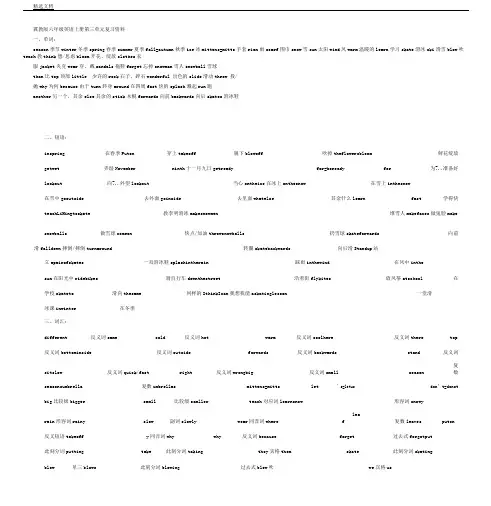
冀教版六年级英语上册第三单元复习资料一、单词:season季节winter冬季spring春季summer夏季fall=autumn秋季ice冰mittens=mitts手套rian雨scarf围巾snow雪sun太阳wind风warm温暖的learn学习skate滑冰ski滑雪blow吹teach教think想/思虑bloom开花、绽放clothes衣服jacket夹克wear穿、戴sandals拖鞋forget忘掉snowman雪人snowball雪球than比top顶部little 少许的rock石子、碎石wonderful 出色的slide滑动throw 投/抛why为何because由于turn转身around在四周fast快的splash溅起run跑another另一个,其余else其余的stick木棍forwards向前backwards向后skates滑冰鞋二、短语:inspring在春季Puton穿上takeoff脱下blowoff吹掉theflowersbloom鲜花绽放getwet弄湿November ninth十一月九日getready for=beready for为?..准备好lookout向?..外望lookout当心ontheice在冰上onthesnow在雪上inthesnow在雪中gooutside去外面goinside去里面whatelse其余什么learn fast学得快teachLiMingtoskate教李明滑冰makesnowmen堆雪人makefaces做鬼脸make snowballs 做雪球comeon快点/加油throwsnowballs扔雪球skateforwards向前滑falldown摔倒/摔倒turnaround转圈skatebackwards向后滑Standup站立apairofskates一双滑冰鞋splashintherain踩雨inthewind在风中inthesun在阳光中ridebikes骑自行车downthestreet沿着街flykites放风筝atschool在学校skateto滑向thesame同样的IthinkIcan我想我能askatinglesson一堂滑冰课inwinter在冬季三、词汇:different反义词same cold反义词hot warm反义词coolhere反义词there top 反义词bottominside反义词outside forwards反义词backwards stand反义词sitslow反义词quick/fast right反义词wrongbig反义词small season 复数seasonsumbrella复数umbrellas mittens=mitts let’s=letus don’t=donot big比较级bigger samll比较级samller teach对应词learnsnow形容词snowyrain形容词rainy slow副词slowly wear同音词whereleaf复数leaves puton反义短语takeoff y同音词why why反义词because forget过去式forgotput 此刻分词putting take此刻分词taking they宾格them skate此刻分词skating blow单三blows此刻分词blowing过去式blew吹we宾格uswear单三wears此刻分词wearing过去式wore穿we形代our put单三puts此刻分词putting过去式put搁置we物代ourstake单三takes此刻分词taking过去式took拿去they形代theirthink单三thinks此刻分词thinking过去式thought想they物代theirsslide单三slides此刻分词sliding过去式slid滑snowman复数snowmen throw单三throws此刻分词throwing过去式threw扔let’s完整式letusteach单三teaches此刻分词teaching过去式taugh教one序数词firstlearn单三learns此刻分词learning过去式learnt学great同义词wonderfulrun单三runs此刻分词running过去式ran跑do单三形式doesfly单三flies此刻分词flying过去式flew飞sun形容词sunny四、句型:1.Therearefourseasonsinayear一.年有四时2.Whatdoyouwearinwinter/inspring/insummer/infall?在冬季/春季/夏季/秋季你穿什么衣服?Iwear---我穿---3.Whatdoyouliketodoinwinter?你在冬季喜爱做什么?4.Iliketoskateontheice.我喜爱在冰上滑冰5.Iliketoskionthesnow.我喜爱在雪上滑雪What’syourfavouiteseason?你最喜爱的季节是什么?Ilikewinter(季节).Why?为何?BecauseIliketo skion thesnow.由于我喜爱在雪上滑雪。
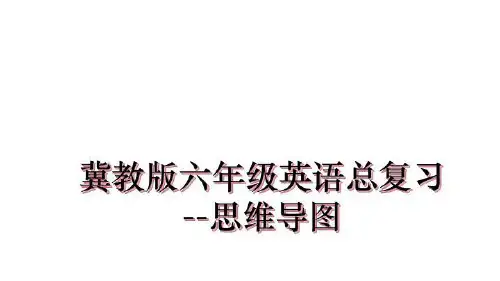
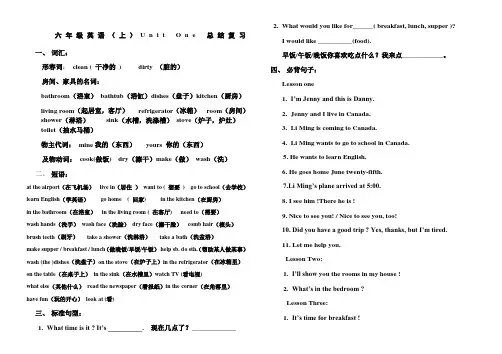
六年级英语(上)U n i t O n e总结复习一、词汇:形容词:clean ( 干净的) dirty (脏的)房间、家具的名词:bathroom(浴室)bathtub(浴缸)dishes(盘子)kitchen(厨房)living room(起居室,客厅)refrigerator(冰箱)room(房间)shower(淋浴)sink(水槽,洗涤槽)stove(炉子,炉灶)toilet(抽水马桶)物主代词:mine我的(东西)yours 你的(东西)及物动词:cook(做饭) dry(擦干)make(做)wash(洗)二、短语:at the airport(在飞机场)live in(居住)want to ( 想要) go to school(去学校)learn English(学英语)go home ( 回家) in the kitchen(在厨房)in the bathroom(在浴室)in the living room ( 在客厅) need to(需要)wash hands(洗手)wash face(洗脸)dry face(擦干脸)comb hair(梳头)brush teeth(刷牙)take a shower(洗淋浴)take a bath(洗盆浴)make supper / breakfast / lunch(做晚饭/早饭/午饭)help sb. do sth.(帮助某人做某事)wash (the )dishes(洗盘子)on the stove(在炉子上)in the refrigerator(在冰箱里)on the table(在桌子上)in the sink(在水槽里)watch TV (看电视)what else(其他什么)read the newspaper(看报纸)in the corner(在角落里)have fun(玩的开心)look at (看)三、标准句型:1.What time is it ? It’s __________. 现在几点了?_____________2.What would you like for______( breakfast, lunch, supper )?I would like __________(food).早饭/午饭/晚饭你喜欢吃点什么?我来点____________。
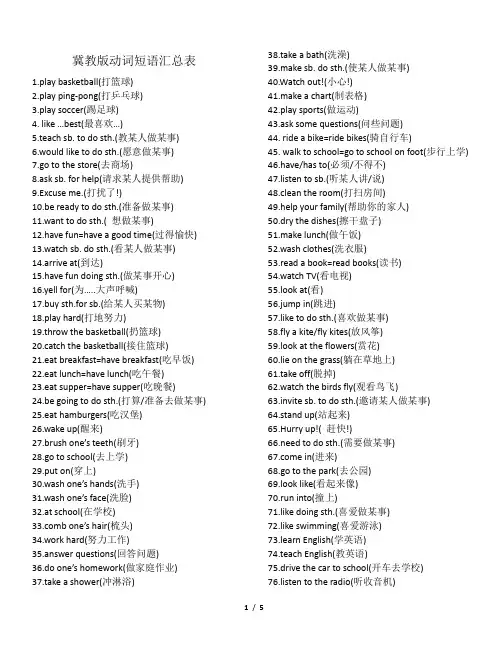
冀教版动词短语汇总表1.play basketball(打篮球)2.play ping-pong(打乒乓球)3.play soccer(踢足球)4. like …best(最喜欢…)5.teach sb. to do sth.(教某人做某事)6.would like to do sth.(愿意做某事)7.go to the store(去商场)8.ask sb. for help(请求某人提供帮助)9.Excuse me.(打扰了!)10.be ready to do sth.(准备做某事)11.want to do sth.( 想做某事)12.have fun=have a good time(过得愉快)13.watch sb. do sth.(看某人做某事)14.arrive at(到达)15.have fun doing sth.(做某事开心)16.yell for(为…..大声呼喊)17.buy sth.for sb.(给某人买某物)18.play hard(打地努力)19.throw the basketball(扔篮球)20.catch the basketball(接住篮球)21.eat breakfast=have breakfast(吃早饭)22.eat lunch=have lunch(吃午餐)23.eat supper=have supper(吃晚餐)24.be going to do sth.(打算/准备去做某事)25.eat hamburgers(吃汉堡)26.wake up(醒来)27.brush one’s teeth(刷牙)28.go to school(去上学)29.put on(穿上)30.wash one’s hands(洗手)31.wash one’s face(洗脸)32.at school(在学校)b one’s hair(梳头)34.work hard(努力工作)35.answer questions(回答问题)36.do one’s homework(做家庭作业)37.take a shower(冲淋浴) 38.take a bath(洗澡)39.make sb. do sth.(使某人做某事)40.Watch out!(小心!)41.make a chart(制表格)42.play sports(做运动)43.ask some questions(问些问题)44. ride a bike=ride bikes(骑自行车)45. walk to school=go to school on foot(步行上学)46.have/has to(必须/不得不)47.listen to sb.(听某人讲/说)48.clean the room(打扫房间)49.help your family(帮助你的家人)50.dry the dishes(擦干盘子)51.make lunch(做午饭)52.wash clothes(洗衣服)53.read a book=read books(读书)54.watch TV(看电视)55.look at(看)56.jump in(跳进)57.like to do sth.(喜欢做某事)58.fly a kite/fly kites(放风筝)59.look at the flowers(赏花)60.lie on the grass(躺在草地上)61.take off(脱掉)62.watch the birds fly(观看鸟飞)63.invite sb. to do sth.(邀请某人做某事)64.stand up(站起来)65.Hurry up!( 赶快!)66.need to do sth.(需要做某事)e in(进来)68.go to the park(去公园)69.look like(看起来像)70.run into(撞上)71.like doing sth.(喜爱做某事)72.like swimming(喜爱游泳)73.learn English(学英语)74.teach English(教英语)75.drive the car to school(开车去学校)76.listen to the radio(听收音机)77.go on a trip/go on trips(去旅行)78.fly home (乘飞机回家)79.say hello to sb.(向某人问好)80.call sb. on the phone(给某人打电话)81.walk slowly(走得慢)82. walk quickly(走得快)83.play cards(打牌)84.arrive in(到达)85.go for a walk(散步)86.walk down the street(沿着街走)87.take a picture=take pictures(拍照)88.go shopping(购物)89.get wet(变湿)90.be/get ready for(为……做好准备)91.make a snowman=make snowmen(堆雪人)92.Look out!(小心)93.walk forwards/backwards(向前走/向后走)94.turn around(转圈)95. all down(摔倒)96.flowers bloom(花开)e on (过来/加油!)98.blow…off(把……从……上吹落))99. look out the window(朝窗子外面看) 100.go inside(进来)101.go outside(出去)102.put up(装扮)103.send a card/send cards(寄贺卡)104.sing a song/sing songs(唱歌)105.bring gifts(带来礼物)106. walk to the park(步行去公园)107.eat eggs(吃鸡蛋)108.bring toys(带来玩具)109.help sb. with sth.(某人做某事)110.Christmas gifts(圣诞礼物)冀教版教材同音词汇总记忆表buy(买)-by(乘……)-bye(再见)two(二)-too(也)-to(到) I(我)-eye(眼睛)four(四)-for(为了)hi(嘿)-high(高)know(知道)-no(不)hear(听见)-here(这儿)their(他们的)-there(那儿)meet(碰见)-meat(肉)sun(太阳)-son(儿子)see(看见)-sea(大海)hour(小时)-our(我们的)write(写)-right(右面的/正确的)weak(虚弱的)-week(周)new(新的)-knew(know的过去式)one(一)-won(win的过去式)aren’t(are和not的缩写)-aunt(婶/舅/姑/姨母) its(它的)-it’s(it和is的缩写)Miss(小姐)-miss(想念)May(五月)-may(可以)冀教版不规则动词过去式分类记忆a.完全不规则:am,is-was, are-were, do/does-did, go-went, see-saw, say-said, have/has-had, fly-flew, speak-spoke, buy-bought, bring-brought, think-thought, teach-taught, eat-ate, lie-lay, can-could, will-would.b.改变其中的元、辅音字母:give-gave, get-got, forget-forgot, come-came, run-ran, sing-sang, write-wrote, draw-drew, drink-drank, ride-rode, swim-swam, shine-shone, find-found, win-won, lose-lost, make-made.c.原形和过去式同形:read-read, put-put,hit-hit, hurt-hurt, cost-cost.冀教版教材对应词和反义词汇boy(男孩)-girl(女孩)man(男士)-woman(妇女)brother(兄弟)-sister(姐妹)father(父亲)-mother(母亲)dad(爸爸)-mum(妈妈)uncle(叔叔)-aunt(婶婶) husband(丈夫)-wife(妻子)day(白天)-night(夜晚)morning(早上)-afternoon(下午) east(东方)-west(西方)north(北方)-south(南方)big(大的)-small(小的)old(旧的)-new(新的)old(老的)-young(少的)tall(高的)-short(矮的)long(长的)-short(短的)left(左面)-right(右面)wrong(错误的)-right(正确的) black(黑色的)-white(白色的) good(好的)-bad(坏的)happy(高兴地)-sad(悲伤的)dirty(脏的)-clean(干净的)heavy(重的)-light(轻的)hungry(饥饿的)-full(饱的)cold(冷的)-hot(热的)warm(温暖的)-cool(凉爽的)fat(胖的)-thin(瘦的)dry(干的)-wet(湿的)hard(难的)-easy(容易得)quiet(安静的)-loud(大声的) quick(快的)-slow(慢的)far(远的)-near(近的)high(高的)-low(低的)strong(强壮的)-weak(虚弱的) healthy(健康的)-sick(有病的) different(不同的)-same(相同的) expensive(昂贵的)-cheap(便宜的) here(这儿)-there(那儿)late(迟的)-early(早的)first(首先)-finally(最后)always(总是)-never(从来不) inside(里面)-outside(外面)up(向上)-down(向下)quickly(快地)-slowly(慢地)quietly(安静地)-loudly(大声地)well(好)-badly(坏)fast(快的、快地)-slow(慢的)/slowly(慢地) this(这个)-that(那个)these(这些)-those(那些)come(来)-go(去)yes(是)-no(不是)stand(站)-sit(坐)open(打开)-close(关上)ask(问)-answer(答)borrow(借来)-lend(借出)bring(带来)-take(带走)buy(买)-sell(卖)cry(哭)-laugh(笑)teach(教)-learn(学)better(更好)-worse(更坏)before(在……之前)-after(在……之后) above(在……以上)-below(在……以下)冀教版常用交际用语汇总记忆表问候:Hi! Hello! Goodmorning/afternoon/evening! Nice to meet you! Nice to meet you, too.A:How are you? B: Fine, thank you./Very well, thank you.介绍:My name is ____. / I am a student. / I’m from Canada. /This is ______.告别:Good-bye! /Bye! /Bye-bye! Good night! See you later /tomorrow!感谢:-Thank you(very much)/ Thanks a lot. -That’s OK. / That’s All right. / You are welcome. / Not at all.道歉:-Sorry. / I am sorry. -That’s OK. / It’s all right.邀请:-Would you like to go for a walk? / Will/Would you come to my birthday party?-Sure. / No, thanks.请求允许:-May I go on a trip to Beijing?-Yes, you may. / No, you may not. / Sure. / Certainly. -Can I use your pencil?-Of course, you can.祝愿与祝贺:Have a lovely day! / Good luck! / Happy New Year! / Merry Christmas!You, too. / The same to you. -Happy birthday!-Thank you.约会:A:Would you like to play with me this afternoon? B: Yes. When? A:At 12:00.B: See you then.打电话:A:Hello! May I speak to Mr. Wood? B:Yes, just a moment, please.A:Hello! Is Kim there? B:No /Sorry, can I take a message.就医:A:What’s the matter?/What’s wrong with you? B:I hurt my finger. I have a headache/stomachache.就餐:A:Would you like something to eat / drink? B: Yes. I would like rice and chicken.A:What would you like?B:I would like some tea.A:Would you like some more dumplings?B:Yes, please. / No, thanks / thank you.A:May I have some more soup?B:It’s delicious. Sure / OK.购物:A:Can/May/I help you?B: Yes. I want to buy a dress, please.A:Here you are.B: May I try it on?A:Ok/Sure.B: It’s too big/small.A:This one is just right.B: How much is it/ are they?A:One hundred yuan /dollars.B: It’s too expensive. /It’s very cheap. But I like it. I’ll take it.问路:A:Excuse me. Do you know where isthe________?B: Yes. Go straight down the street. Turn left /turn right.提供帮助:A: Can I help you? /May I help you? B: Yes, please. / No, thanks.询问对方姓名:A:What’s your name?B:My name is ____.A:What’s his/ her name?B: His /her name is ___.A:Who are you?B: I’m _____.询问在那儿:A: Where is the book?B:It is on the desk.A:Where is Jenny?B:She is behind Danny.询问是什么:A:What is it?B: It is a marker.询问颜色:A:What colour is the sweater?B:It is black.询问时间:A:What time is it?B: It’s seven.A:When is Teachers’Day?B: It’s on September tenth.询问地址和住址:A:Where are you from?B: I’m from Canada.A:What’s your address?B: My address is 111 Park Road.A:Where do you live?B: I live in an apartment.询问日期:A:What day is today?B: It’s Monday.A:What day is tomorrow?B: It’s Tuesday.A:What day was yesterday?B: It was Sunday.A:What’s the date?B: It’s October 19th.询问对方正做什么:A: What are you doing?B: I’m writing a letter.A:What is he/ she doing?B: He /she is playing.A:What are they doing?B: They are learning English.询问对方做过些什么:A: What did you do?B: I went to the gym.A:What did they do?B: They played basketball.询问对方将要做什么:A:What will you do?B: I will fly a kite.A:What is he going to do?B: He is going to learn English.询问对方最喜欢的事物:A:What’s your favourite colour /food / fruit /shape/ season?B: My favourite colour is white.询问数量:A:How many pencils do you have? B: I have 10 pencils.A:How many birds can you see?B: I can see 20 birds.A:How many days are there in a week?B: There are seven days in a week.询问价钱:A:How much is the scarf?B: Twenty yuan.A:How much are the runners?B: They are thirty dollars.谈论天气气温:A:How’s the weather today?B: It’s sunny/cloudy/windy/snowy.A:What’s the temperature?B: It’s _______degrees.询问年龄:A:How old are you?B:I’m fourteen years old.A:How old is she/ he?B: He/ She is twenty .询问身高:A:How tall are you?B: I’m 1.6 meters tall.A:How tall is she/ he?B: She/ he is 1.7 meters tall.询问事情发生的频率:A:How often do you play basketball?B: About once a week.A:How often does my mother clean my bedroom? B: Twice a day.询问事情距离长短:A:How long is the trip? B: About two hours to Beijing.A:How long does he go to school a day ?B: Eight hours.询问路程的远近:A:How far is it from here to Beijing?B: It’s one hundred kilometers.询问对方感觉怎么样: A:How do you feel?B: I feel sad.询问对方是谁,问谁在做些什么?A:Who is this? B: This is a man.A:Who is talking? B: Danny is talking.询问东西是谁的:A:Whose hat is this?B: This is my hat /mine.询问原因:A: I like to eat vegetables. Why?B:Because it’s good for your health.。
冀教版六年级英语上册复习资料Unit11.词汇短语home家time 时间clock钟表house房子living room 客厅kitchen厨房bathroom浴室toilet坐便器bedroom卧室floor 地板Study书房half 一半fridge冰箱dishes 盘子table 桌子tomato(es)西红柿potatoes土豆dirty 脏的——clean干净的dry干的,擦干wet湿的in fron t of….在….前面wash洗cook做饭make制作lunch午餐dinner 晚餐always总是sometimes 有时often经常usually通常never 从不umbrella雨伞bus stop公共汽车站Bus driver公共汽车司机school bus 校车ride骑walk走subjects科目class课science科学math 数学lesson 课weather天气temperature 温度degrees度数healthy健康的ill 生病的be safe注意安全be careful 小心put…..for…… 用…..表示…..1,What time is it?几点了?It’s four o’clock.四点整/half past four. 四点半。
2, Did you have a good trip?你旅途愉快吗?3. He wants to learn English. 他想学英语。
4,I’ll show you the rooms in my house.我带你参观我家。
5, It’s time for breakfast.该吃早餐了。
5, Let’s put the dishes on the table.让我们把盘子放在桌子上。
6, W hat’s for dinner?晚饭吃什么?7, What would you like for breakfast?早餐你想吃什么?8, I wash the dirty dishes.我洗脏盘子。
冀教版小学英语总复习资料冀教版教材中所学名词分类汇总记忆表学习用品类:pen(钢笔), pencil(铅笔), book(书), eraser(橡皮), ruler(尺子),pencil-case(铅笔盒), marker(彩笔), bag(书包), glue(胶水), scissors(剪刀),paper(纸), sharpener(卷笔刀).教室内物品类:door(门), window(窗户), blackboard(黑板), desk(课桌), chair(椅子), map(地图), picture(图画), light(灯), chalk(粉笔), floor(地板), wall(墙).房间名称类:house(房子), apartment(公寓), room(房间), bedroom(卧室), living room(客厅), kitchen(厨房), bathroom(卫生间).家用物品类:bed(床), television=TV(电视), table(桌子), telephone(电话), computer(电脑), refrigerator=fridge(电冰箱), closet(衣橱), dresser(床头柜), lamp(台灯),sofa(沙发), couch(长沙发), camera(照相机), cup(茶杯), glass(玻璃杯),bowl(碗), dish(盘子), chopsticks(筷子), spoon(勺子), fork(叉子), towel(毛巾), sink(水槽), stove(炉子), toilet(马桶), shower(淋浴器), bathtub(浴盆),brush(刷子), toothbrush(牙刷), umbrella(雨伞).交通工具类:bus(公共汽车), car(小汽车), truck(大卡车), bicycle=bike(自行车), train(火车), airplane=plane(飞机), ship(轮船), boat(小船), taxi(出租车), cab(出租小汽车).人体部位类:body(身体),head(头), hair(头发), eye(眼睛), ear(耳朵), nose(鼻子), mouth(嘴), face(脸), neck(脖子), shoulder(肩膀), arm(胳膊), elbow(胳膊肘),hand(手), finger(手指), stomach (肚子), leg(腿), knee(膝盖), foot(脚)→复数feet, toe(脚趾).动物名称类:cat(猫), dog(狗), pig(猪), duck(鸭子), goose(鹅)→复数geese, bird(鸟), chicken(母鸡), chick(小鸡), cock(公鸡), bee(蜜蜂), butterfly(蝴蝶), cow(奶牛), horse(马), rabbit(兔子), monkey(猴子), panda(熊猫), tiger(老虎),lion(狮子), bear(熊), elephant(大象), donkey(驴), snake(蛇), frog(青蛙),fish(鱼), sheep(绵羊), goat(山羊), fox(狐狸), wolf(狼), mouse(老鼠)→复数mice, zebra(斑马), camel(骆驼), deer(鹿), giraffe(长颈鹿), kangaroo(袋鼠).水果名称类:apple(苹果), banana(香蕉), pear(梨子), peach(桃子), orange(桔子),grape(葡萄), strawberry(草莓), melon(瓜), watermelon(西瓜),pineapple(菠萝), mango(芒果), coconut(椰子).食品名称类:bread(面包), egg(鸡蛋), hamburger(汉堡包), sandwich(三明治), hot dog(热狗), ice cream(冰激凌), cake(蛋糕), cookies(饼干), pizza(比萨饼), donut(面包圈), toast(烤面包), jam(果酱), noodles(面条), dumplings(饺子), rice(米饭),soup(汤), French fries(炸薯条), sausage(香肠), beef(牛肉), mutton(羊肉),fish(鱼肉), pork(猪肉), chicken(鸡肉).蔬菜名称类:cabbage(卷心菜), onion(洋葱), carrot(胡萝卜), pea(豌豆), eggplant(茄子), tomato(西红柿), potato(土豆), beans(豆子).饮料名称类:juice(果汁), milk(牛奶), pop(汽水), coffee(咖啡), coke(可乐), tea(茶), water(水).家庭成员类:grandfather(祖父/外祖父), grandmother(祖母/外祖母), grandpa(爷爷/姥爷), grandma(奶奶/姥姥), father(父亲), dad(爸爸), mother(母亲), mum/mom(妈妈),brother(兄/弟), sister(姐/妹), uncle(伯/叔/舅/姑/姨父), aunt(伯/婶/舅/姑/姨母),cousin(堂/表兄弟姐妹).职业名称类:doctor(医生), nurse(护士), teacher(老师), worker(工人), driver(司机), farmer(农民), policeman(警察), pupil(小学生), student(中学生), clerk(职员),businessman(男商人), businesswoman(女商人), waiter(男服务员), waitress(女服务员), cashier(收银员), writer(作家), singer(歌手), actor(演员), dancer(舞蹈演员).服装名称类:blouse(男衬衫), shirt(女衬衫), T-shirt(T恤衫), skirt(短裙), dress(连衣裙), jacket(夹克衫), cap(太阳帽), hat(礼帽), coat(大衣), sweater(毛衣), pants (长裤), shorts(短裤), jeans(牛仔裤), sock(袜子), shoe(鞋子), sandals(露趾凉鞋),mittens=mitts(连指手套), gloves(分指手套), scarf(围巾), raincoat(雨衣),swimsuit(游泳衣).球类名称类:basketball(篮球), football(足球), volleyball(排球), tennis(网球),ping-pong=table tennis(乒乓球), badminton(羽毛球), baseball(棒球).方位名称类:east(东方),west(西方), north(北方), south(南方).公共场所类:park(公园), library(图书馆), gym(体育馆), shop(商店), store(商场), cinema=movie theatre(电影院), restaurant(餐馆), market(市场), hotel(宾馆). 一日三餐类:breakfast(早餐), lunch(午餐), supper=dinner(晚餐).季节名称类:season(季节), winter(冬季), spring(春季), summer(夏季), fall=autumn(秋季). 星期名称类:week(周), Sunday(星期日), Monday(星期一), Tuesday(星期二),Wednesday(星期三),Thursday(星期四), Friday(星期五), Saturday(星期六). 月份名称类:month(月), January(一月), February(二月), March(三月), April(四月), May(五月), June(六月), July(七月), August(八月), September(九月),October(十月), November(十一月), December(十二月).图形名称类:shape(图形、形状), line(直线), circle(圆形), square(方形), triangle(三角形).节日名称类:New Year’s Day(新年、元旦), Spring Festival(春节), Women’s Day(妇女节), International workers’ Day=May Day(国际劳动节), Children’s Day(儿童节),Teachers’ Day(教师节), National Day(国庆节), Christmas Day(圣诞节).冀教版教材中所学动词短语汇总记忆表1.play basketball(打篮球)2.play ping-pong(打乒乓球)3.play soccer(踢足球)4. like …best(最喜欢…)5.teach sb. to do sth.(教某人做某事)6.would like to do sth.(愿意做某事)7.go to the store(去商场)8.ask sb. for help(请求某人提供帮助)9.Excuse me.(打扰了!) 10.be ready to do sth.(准备做某事) 11.want to do sth.( 想做某事) 12.have fun=have a good time(过得愉快/玩得开心) 13.watch sb. do sth.(看某人做某事) 14.arrive at(到达) 15.have fun doing sth.(做某事开心) 16.yell for(为…..大声呼喊)17.buy sth.for sb.(给某人买某物) 18.play hard(打地努力) 19.throw the basketball(扔篮球) 20.catch the basketball(接住篮球) 21.eat breakfas=have breakfast(吃早饭)22.eat lunch=have lunch(吃午餐) 23.eat supper=have supper(吃晚餐) 24.be going to do sth.(打算/准备去做某事) 25.eat porridge(喝粥) 26.wake up(醒来) 27.brush one’s teeth(刷牙) 28.go to school(去上学) 29.put on(穿上) 30.wash one’s hands(洗手) 31.wash one’s face(洗脸) 32.at school(在学校) b one’s hair(梳头) 34.work hard(努力工作)35.answer questions(回答问题) 36.do one’s homework(做家庭作业) 37.take a shower(冲淋浴) 38.take a bath(洗澡) 39.make sb. do sth.(使某人做某事) 40.Watch out!(小心!) 41.make a chart(制表格) 42.play sports(做运动) 43.ask some questions(问些问题) 44. ride a bike=ride bikes(骑自行车)45. walk to school=go to school on foot(步行去学校) 46.have/has to(必须/不得不)47.listen to sb.(听某人讲/说) 48.clean the room(打扫房间) 49.help your family(帮助你的家人) 50.dry the dishes(擦干盘子) 51.make lunch(做午饭) 52.wash clothes(洗衣服)53.read a book=read books(读书) 54.watch TV(看电视) 55.look at(看) 56.jump in(跳进) 57.like to do sth.(喜欢做某事) 58.fly a kite/fly kites(放风筝)59.look at the flowers(赏花) 60.lie on the grass(躺在草地上) 61.take off(脱掉) 62.watch the birds fly(观看鸟飞) 63.invite sb. to do sth.(邀请某人做某事) 64.stand up(站起来) 65.Hurryup!( 赶快!) 66.need to do sth.( 需要做某事) e in(进来) 68.go to the park(去公园) 69.look like(看起来像) 70. run into(撞上) 71.like doing sth.(喜爱做某事) 72.like swimming(喜爱游泳) 73.learn English(学英语) 74.teach English(教英语) 75.drive the car to school(开车去学校) 76.listen to the radio(听收音机) 77.go on a trip/go on trips(去旅行) 78. fly home/come back home by plane(乘飞机回家) 79.say hello to sb.(向某人问好) 80. call sb. on the phone(给某人打电话) 81.walk slowly(走得慢) 82. walk quickly(走得快) 83.play cards(打牌) 84.arrive in(到达) 85.go for a walk(散步) 86.walk down the street(沿着街走) 87.take a picture=take pictures(拍照) 88.go shopping(购物) 89.get wet(变湿)90.be/get ready for(为……做好准备) 91.make a snowman=make snowmen(堆雪人)92.Look out!(小心) 93.walk forwards/backwards(向前走/向后走) 94.turn around(转圈)95. all down(摔倒) 96.flowers bloom(花开) e on (过来/加油!) 98.blow…off(把……从……上吹落))99. look out the window(朝窗子外面看) 100.go inside(进来) 101.go outside(出去) 102.put up(装扮) 103.send a card/send cards(寄贺卡) 104.sing a song/sing songs(唱歌)105.bring gifts(带来礼物)106. walk to the park(步行去公园)107.eat eggs(吃鸡蛋)108.bring toys(带来玩具)109.help sb. with sth.(某人做某事) 110.Christmas gifts(圣诞礼物)冀教版教材中所学过的不规则动词的过去式分类记忆表a.完全不规则:am,is-was, are-were, do/does-did, go-went, see-saw, say-said,have/has-had, fly-flew, speak-spoke, buy-bought, bring-brought, think-thought,teach-taught, eat-ate, lie-lay, can-could, will-would.b.改变其中的元、辅音字母:give-gave, get-got, forget-forgot, come-came, run-ran, sing-sang, write-wrote,draw-drew, drink-drank, ride-rode, swim-swam,shine-shone, find-found, win-won, lose-lost, make-made.c.原形和过去式同形:read-read, put-put, hit-hit, hurt-hurt, cost-cost.冀教版教材中所学的对应词和反义词汇总记忆表boy(男孩)-girl(女孩), man(男士)-woman(妇女), brother(兄弟)-sister(姐妹), father(父亲)-mother(母亲), dad(爸爸)-mum(妈妈), grandfather(祖父)-grandmother(祖母), uncle(叔叔)-aunt(婶婶), husband(丈夫)-wife(妻子), day(白天)-night(夜晚), morning(早上)-afternoon(下午), east(东方)-west(西方), north(北方)-south(南方), big(大的)-small(小的), old(旧的)-new(新的), old(老的)-young(少的), tall(高的)-short(矮的), long(长的)-short(短的), left(左面)-right(右面), wrong(错误的)-right(正确的), black(黑色的)-white(白色的), good(好的)-bad(坏的), happy(高兴地)-sad(悲伤的), dirty(脏的)-clean(干净的), heavy(重的)-light(轻的), hungry(饥饿的)-full(饱的), cold(冷的)-hot(热的), warm(温暖的)-cool(凉爽的), fat(胖的)-thin(瘦的), dry(干的)-wet(湿的), hard(难的)-easy(容易得), quiet(安静的)-loud(大声的), quick(快的)-slow(慢的), far(远的)-near(近的), high(高的)-low(低的), strong(强壮的)-weak(虚弱的), healthy(健康的)-sick(有病的), different(不同的)-same(相同的), expensive(昂贵的)-cheap(便宜的), here(这儿)-there(那儿), late(迟的)-early(早的), first(首先)-finnally(最后), always(总是)-never(从来不), inside(里面)-outside(外面), up(向上)-down(向下), quickly(快地)-slowly(慢地), quietly(安静地)-loudly(大声地), well(好)-badly(坏), fast(快的、快地)-slow(慢的)/slowly(慢地), this(这个)-that(那个), these(这些)-those(那些), come(来)-go(去), yes(是)-no(不是),stand(站)-sit(坐), open(打开)-close(关上), ask(问)-answer(答), borrow(借来)-lend(借出), bring(带来)-take(带走), buy(买)-sell(卖), cry(哭)-laugh(笑), teach(教)-learn(学), better(更好)-worse(更坏), before(在……之前)-after(在……之后), above(在……以上)-below(在……以下).冀教版教材中所学的同音词汇总记忆表buy(买)-by(乘……)-bye(再见), two(二)-too(也)-to(到) I(我)-eye(眼睛), four(四)-for(为了), hi(嘿)-high(高), know(知道)-no(不), hear(听见)-here(这儿), their(他们的)-there(那儿),meet(碰见)-meat(肉), sun(太阳)-son(儿子), see(看见)-sea(大海), hour(小时)-our(我们的), write(写)-right(右面的/正确的), weak(虚弱的)-week(周), new(新的)-knew(know的过去式), one(一)-won(win的过去式), aren’t(are和not的缩写)-aunt(婶/舅/姑/姨母), its(它的)-it’s(it和is的缩写), Miss(小姐)-miss(想念), May(五月)-may(可以).冀教版教材中常用交际用语汇总记忆表问候:Hi! Hello! Good morning/afternoon/evening! Nice to meet you! Nice to meet you, too. A:How are you? B: Fine,thank you./Very well,thank you.介绍:My name is ____. / I am a student. / I’m from Canada. /This is ______.告别:Good-bye! /Bye! /Bye-bye!Good night!See you later /tomorrow!感谢:Thank you(very much)/ Thanks a lot. -That’s OK. / That’s All right. / You are welcome. / Not at all.道歉:-Sorry. / I am sorry. -That’s OK. / It’s all right.邀请Would you like to go for a walk? / Will /Would you come to my birthday party?-Sure. / No, thanks.请求允许:-May I go on a trip to Beijing?-Yes, you may. / No, you may not. / Sure. / Certainly.-Can I use your pencil?-Of course, you can.祝愿与祝贺:Have a lovely day! / Good luck! / Happy New Year! / Merry Christmas! You, too. / The same to you. -Happy birthday!-Thank you.约会:A: Would you like to play with me this afternoon? B: Yes. When? A: At 12:00.B: See you then.打电话:A: Hello! May I speak to Mr. Wood?B: Yes, just a moment, please.A: Hello! Is Kim there? B: No /Sorry, can I take a message.就医:A: What’s the matter?/What’s wrong with you? B:I hurt my finger. I have a headache /stomachache.就餐:A:Would you like something to eat / drink? B: Yes. I would like rice and chicken. A: What would you like? B:I would like some tea.A: Would you like some more dumplings? B: Yes, please. / No, thanks / thank you.A: May I have some more soup? B: It’s delicious. Sure / OK.购物:A: Can/May/I help you? B: Yes. I want to buy a dress, please.A:Here you are. B: May I try it on? A: Ok /Sure. B: It’s too big/small.A:This one is just right. B: How much is it/ are they? A:One hundred yuan /dollars. B: It’s too expensive. /It’s very cheap. But I like it. I’ll take it.问路:A:Excuse me. Do you know where is the________?B: Yes. Go straight down the street. Turn left /turn right.提供帮助:A: Can I help you? /May I help you? B: Yes, please. / No, thanks.询问对方姓名:A:What’s your name?B:My name is ____.A:What’s his/ her name?B: His /her name is ___.A:Who are you? B: I’m _____.询问在那儿:A: Where is the book? B:It is on the desk.A:Where is Jenny? B:She is behind Danny.询问是什么:A:What is it? B: It is a marker.询问颜色:A:What colour is the sweater? B:It is black.询问时间:A:What time is it? B: It’s seven.A:Whe n is Teachers’Day?B: It’s on September tenth.询问地址和住址:A:Where are you from? B: I’m from Canada.A:What’s your address?B: My address is 111 Park Road.A:Where do you live? B: I live in an apartment.询问日期:A:What day is today? B: It’s Monday.A:What day is tomorrow? B: It’s Tuesday.A:What day was yesterday? B: It was Sunday.A:What’s the date?B: It’s October 19th.询问对方正做什么:A:What are you doing? B: I’m writinging a letter.A:What is he/ she doing? B: He /she is playing.A:What are they doing? B: They are learning English.询问对方做过些什么:A:What did you do? B: I went to the gym.A:What did they do? B: They played basketball.询问对方将要做什么:A:What will you do? B: I will fly a kite.A:What is he going to do? B: He is going to learn English.询问对方最喜欢的事物:A:What’s your favourite colour /food / fruit /shape/ season? B: My favourite colour is white.询问数量:A:How many pencils do you have? B: I have 10 pencils.A:How many birds can you see? B: I can see 20 birds.A:How many days are there in a week? B: There are seven days in a week.询问价钱:A:How much is the scarf? B: Twenty yuan.A:How much are the runners? B: They are thirty dollars.谈论天气气温:A:How’s the weather today?B: It’s sunny/cloudy/windy/snowy. A:What’s the temperature?B: It’s _______degrees.询问年龄:A:How old are you? B:I’m fourteen years old.A:How old is she/ he? B: He/ She is twenty .询问身高:A:How tall are you? B: I’m 1.6 metres tall.A:How tall is she/ he? B: She/ he is 1.7 metres tall.询问事情发生的频率:A:How often do you play basketball? B: About once a week.A:How often does my mother clean my bedroom? B: Twice a day.询问事情距离长短:A:How long is the trip? B: About two hours to Beijing. A:How long does he go to school a day ? B: Eight hours.询问路程的远近:A:How far is it from here to Beijing? B: It’s one hundred kiliometres.询问对方感觉怎么样: A:How do you feel? B: I feel sad.询问对方是谁,问谁在做些什么?A:Who is this? B: This is a man.A:Who is talking? B: Danny is talking.询问东西是谁的:A:Whose hat is this? B: This is my hat /mine.询问原因:A: I like to eat vegetables. Why? B:Because it’s good for your health.。